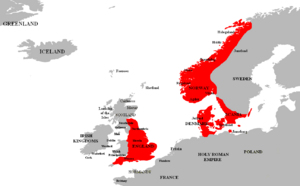House of Knýtlinga facts for kids
Quick facts for kids Jelling dynastyJellingdynastiet
|
|
|---|---|
| Royal dynasty | |
| Country | |
| Founded | c. 916 |
| Founder | Harthacnut I of Denmark |
| Current head | None; extinct |
| Final ruler | Cnut III & II |
| Dissolution | 1042 |
| Branches |
|
The House of Knýtlinga was a powerful family of kings in the Middle Ages. They ruled parts of Scandinavia and England. This family is also known as the Jelling dynasty or the House of Cnut.

The most famous king from this family was Cnut the Great. He was so important that the family is sometimes named after him. Other key members included Cnut's father, Sweyn Forkbeard, and his grandfather, Harald Bluetooth. Cnut's sons, Harthacnut, Harold Harefoot, and Svein Knutsson, also played big roles.
Under King Harald Bluetooth, the family helped unite what is now Denmark. They also claimed to rule Norway, though their power there was not always strong. This family helped Denmark become a more organized kingdom.
Around 1018 AD, the House of Knýtlinga brought the crowns of Denmark and England together. This meant one king ruled both countries. At its strongest, from 1028 to 1030, the family ruled Denmark, England, and Norway. However, after Cnut the Great's sons died, the family's power faded. The Norman conquest of England in 1066 further changed history.
Contents
Kings of Denmark
The Jelling dynasty built amazing ring fortresses, which were large circular forts. They also created new ways to organize their army. These kings were important in bringing Christianity to Denmark.
They also started making coins in Scandinavia for the first time. This helped their kingdoms become more like other European countries. Some historians believe the first rulers of this family, like Harthacnut I or Gorm, might have come from other lands. The Jelling dynasty also started clear rules for who would become king next in Denmark.
Kings of England
The House of Knýtlinga ruled the Kingdom of England from 1013 to 1014, and again from 1016 to 1042.
In 1013, Sweyn Forkbeard was already king of Denmark and Norway. He took over England from King Æthelred the Unready. Sweyn had first attacked England in 1003. He wanted to get revenge for the death of his sister and many other Danes. They had been killed in a terrible event ordered by King Æthelred in 1002.
Sweyn died in 1014, and Æthelred became king of England again. But in 1015, Sweyn's son, Cnut the Great, invaded England. After Æthelred died in 1016, his son Edmund Ironside briefly became king. But Edmund had to give half of England to Cnut. When Edmund died later that year, Cnut became the king of all England. Scotland and Norway also accepted Cnut as their ruler.
Cnut was already married to Ælfgifu of Northampton. But he also married Æthelred's widow, Emma of Normandy. Cnut ruled England until he died in 1035. After his death, another of Æthelred's sons, Alfred Aetheling, tried to take the English throne. But he was captured and blinded. He died soon after.
Cnut's son, Harold Harefoot, then ruled England until 1040. Harold initially shared England with his half-brother Harthacnut. Harold ruled in the north, and Harthacnut ruled in the south. However, Harthacnut was also king of Denmark and spent most of his time there. So Harold was mostly the sole ruler of England.
Harthacnut later became king of England after Harold died. He is sometimes also called Cnut II. Harthacnut died two years later. His half-brother Edward the Confessor then became king. Edward was the son of Æthelred and Emma. With Edward becoming king, the old English royal family, the House of Wessex, was back on the throne.
England after the House of Knýtlinga
Edward the Confessor ruled until 1066. His brother-in-law, Harold Godwinson, became king next. This led to the Norman conquest of England in the same year. Harold II was the last Anglo-Saxon king to rule England.
The Normans were descendants of Vikings who had settled in a part of France called Normandy. Even though they spoke French, their roots were Viking. So, in a way, the Vikings finally conquered and kept England, even if indirectly.
In 1085–86, King Cnut IV of Denmark planned one last Danish invasion of England. But he was killed by Danish rebels before he could carry it out. This was the last time Vikings tried to attack Western Europe. Cnut's death is seen as the end of the Viking Age.
List of Danish kings of England
- Sweyn Forkbeard, 1013–14 (also king of Denmark and Norway)
- Cnut, 1016–1035 (also king of Denmark and Norway)
- Harold Harefoot, 1035–1040
- Harthacnut, 1040–1042 (also king of Denmark)
Queens consort of England during Danish rule
- Emma of Normandy (1002–1016 and 1017–1035)
- Ælfgifu of Northampton (1016–1035)
See also
- Knýtlinga saga
- Danelaw
- Guthrum
- Ragnar Lodbrok
- Ivar the Boneless
- Eric Bloodaxe
- Harald III of Norway
- Sweyn II of Denmark
- List of English monarchs
Images for kids



